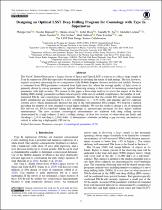| dc.contributor.author | Gris, Philippe | |
| dc.contributor.author | Regnault, Nicolas | |
| dc.contributor.author | Lochner, Michelle | |
| dc.date.accessioned | 2023-02-02T09:19:12Z | |
| dc.date.available | 2023-02-02T09:19:12Z | |
| dc.date.issued | 2023 | |
| dc.identifier.citation | Gris, P. et al. (2023). Designing an optimal LSST deep drilling program for cosmology with type Ia supernovae. Astrophysical Journal, Supplement Series, 264(1), 22. 10.3847/1538-4365/ac9e58 | en_US |
| dc.identifier.issn | 0067-0049 | |
| dc.identifier.uri | 10.3847/1538-4365/ac9e58 | |
| dc.identifier.uri | http://hdl.handle.net/10566/8329 | |
| dc.description.abstract | The Vera C. Rubin Observatory’s Legacy Survey of Space and Time (LSST) is forecast to collect a large sample of
Type Ia supernovae (SNe Ia) expected to be instrumental in unveiling the nature of dark energy. The feat, however,
requires accurately measuring the two components of the Hubble diagram, distance modulus and redshift. Distance
is estimated from SN Ia parameters extracted from light-curve fits, where the average quality of light curves is
primarily driven by survey parameters. An optimal observing strategy is thus critical for measuring cosmological
parameters with high accuracy. We present in this paper a three-stage analysis to assess the impact of the deep
drilling (DD) strategy parameters on three critical aspects of the survey: redshift completeness, the number of wellmeasured SNe Ia, and cosmological measurements. We demonstrate that the current DD survey plans (internal
LSST simulations) are characterized by a low completeness (z ∼ 0.55–0.65), and irregular and low cadences
(several days), which dramatically decrease the size of the well-measured SN Ia sample. We propose a method
providing the number of visits required to reach higher redshifts. We use the results to design a set of optimized
DD surveys for SN Ia cosmology taking full advantage of spectroscopic resources for host galaxy redshift
measurements. The most accurate cosmological measurements are achieved with deep rolling surveys
characterized by a high cadence (1 day), a rolling strategy (at least two seasons of observation per field), and
ultradeep (z 0.8) and deep (z 0.6) fields. A deterministic scheduler including a gap recovery mechanism is
critical to achieving a high-quality DD survey. | en_US |
| dc.language.iso | en | en_US |
| dc.publisher | American Astronomical Society | en_US |
| dc.subject | Astronomy | en_US |
| dc.subject | Physics | en_US |
| dc.subject | Cosmology | en_US |
| dc.subject | Dark energy | en_US |
| dc.title | Designing an optimal LSST deep drilling program for cosmology with type Ia supernovae | en_US |
| dc.type | Article | en_US |

